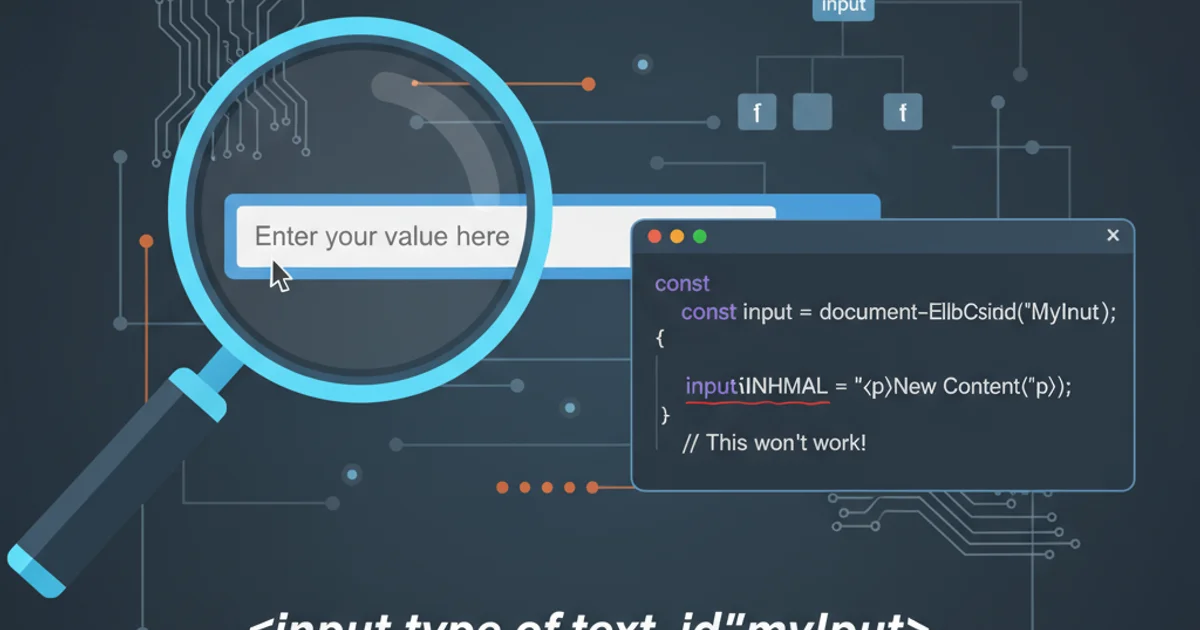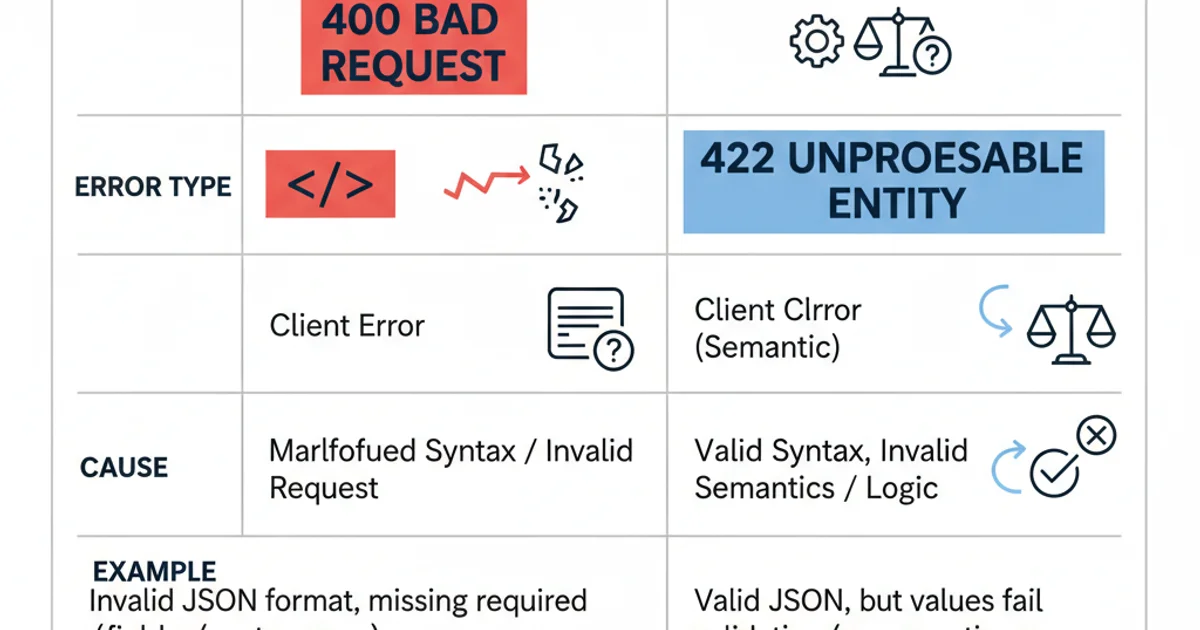400 vs 422 response to POST of data
Categories:
HTTP 400 Bad Request vs. 422 Unprocessable Entity: Choosing the Right Response

Understand the critical differences between HTTP 400 and 422 status codes for POST requests and learn when to use each for robust API design.
When designing RESTful APIs, choosing the correct HTTP status code for error responses is crucial for clear communication between client and server. Two codes that often cause confusion, especially when handling POST requests with invalid data, are 400 Bad Request and 422 Unprocessable Entity. While both indicate client-side errors, their nuances dictate different scenarios for their application. This article will clarify when to use each, ensuring your API provides precise and actionable feedback.
Understanding HTTP 400 Bad Request
The 400 Bad Request status code signifies that the server cannot or will not process the request due to something that is perceived to be a client error. This typically means the request itself is malformed, syntactically incorrect, or violates fundamental HTTP protocol rules. It's a broad error category indicating that the server couldn't even understand what the client was asking for, let alone validate its business logic.
400 Bad Request as a 'syntax error' or 'protocol violation' from the server's perspective. The request doesn't conform to the basic rules of HTTP or the API's expected structure.Common scenarios for a 400 Bad Request include:
- Malformed JSON/XML payload: The request body is not valid JSON or XML.
- Missing required headers: A header essential for the request's interpretation (e.g.,
Content-Type) is absent or incorrect. - Invalid query parameters: Parameters that are syntactically incorrect or don't match expected types (e.g., a non-numeric ID where a number is expected).
- Request URI too long: The URL exceeds the server's maximum length.
- Invalid HTTP method for the resource: Though less common for
POST, using an incorrect method could sometimes fall here if the server can't even parse the intent.
POST /api/users HTTP/1.1
Content-Type: application/json
{ "name": "John Doe", "email": "invalid-email" }
Example of a POST request that might result in a 400 Bad Request if the server expects a specific email format and rejects it at a very early parsing stage, or if the JSON itself is malformed.
flowchart TD
A[Client Sends POST Request] --> B{Server Receives Request}
B --> C{Is Request Syntactically Valid?}
C -- No --> D["400 Bad Request (e.g., Malformed JSON)"]
C -- Yes --> E{Proceed to Business Logic Validation}Flowchart illustrating when a 400 Bad Request might occur.
Understanding HTTP 422 Unprocessable Entity
The 422 Unprocessable Entity status code, defined in RFC 4918 (WebDAV), indicates that the server understands the content type of the request entity, and the syntax of the request entity is correct, but it was unable to process the contained instructions. In simpler terms, the request is syntactically valid, but semantically flawed. The server understood what you sent, but the data itself violates business rules or constraints.
422 Unprocessable Entity is specifically designed for semantic errors in the request payload. It implies that the server successfully parsed the request but found issues with the data's meaning or validity according to application-level rules.Common scenarios for a 422 Unprocessable Entity include:
- Validation errors: A required field is missing, a string is too long, a number is out of range, or an email address is not in a valid format (after successful parsing).
- Business rule violations: Attempting to create a user with a username that already exists, or trying to purchase an item that is out of stock.
- Referential integrity issues: Providing an
idfor a related resource that does not exist in the database. - Conflicting data: The request payload contains data that conflicts with the current state of the resource or other data in the system.
POST /api/products HTTP/1.1
Content-Type: application/json
{ "name": "New Product", "price": -10.00, "category_id": "non-existent-id" }
Example of a POST request that would typically result in a 422 Unprocessable Entity due to invalid price and a non-existent category ID, assuming the JSON is syntactically correct.
flowchart TD
A[Client Sends POST Request] --> B{Server Receives Request}
B --> C{Is Request Syntactically Valid?}
C -- Yes --> D{Is Request Semantically Valid?}
D -- No --> E["422 Unprocessable Entity (e.g., Validation Error)"]
D -- Yes --> F[Process Request Successfully]Flowchart illustrating when a 422 Unprocessable Entity might occur.
Key Differences and When to Use Each
The distinction boils down to the level at which the error occurs. 400 Bad Request is for errors at the HTTP protocol or basic request parsing level. 422 Unprocessable Entity is for errors at the application's business logic or data validation level, after the request has been successfully parsed.

Comparison of 400 Bad Request vs. 422 Unprocessable Entity
Here's a quick summary:
- 400 Bad Request: The server couldn't understand the request. It's a problem with the request's structure or adherence to protocol.
- Example: Sending
{'name': 'value'(missing closing brace) orContent-Type: text/plainwhenapplication/jsonis expected for a JSON body.
- Example: Sending
- 422 Unprocessable Entity: The server understood the request, but the data within it is invalid according to application rules. It's a problem with the request's content or business logic.
- Example: Sending
{"name": "", "age": "abc"}(empty name, non-numeric age) when the API expects a non-empty string for name and an integer for age.
- Example: Sending
400 for all client-side validation errors, adopting 422 provides a more precise and semantically correct response, especially for APIs that adhere closely to REST principles and aim for clear error messaging.Practical Implementation Considerations
When implementing your API, consider the following to decide which status code to return:
1. Initial Request Parsing
First, check if the request body is syntactically valid (e.g., valid JSON). If it fails here, return 400 Bad Request.
2. Data Validation
If the request body is syntactically valid, proceed to validate its content against your application's business rules and data schemas. If any validation fails, return 422 Unprocessable Entity.
3. Error Response Body
For both 400 and 422 errors, provide a clear and informative response body, typically in JSON format. This body should detail what went wrong, which fields are problematic, and why. This helps clients debug their requests effectively.
HTTP/1.1 422 Unprocessable Entity
Content-Type: application/json
{
"message": "Validation Failed",
"errors": [
{
"field": "email",
"code": "invalid_format",
"message": "Email address is not valid."
},
{
"field": "password",
"code": "too_short",
"message": "Password must be at least 8 characters long."
}
]
}
Example of a detailed error response for a 422 Unprocessable Entity.